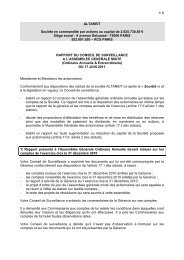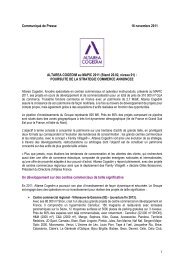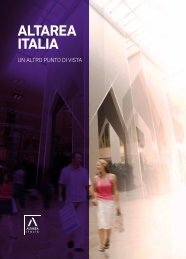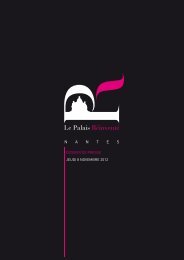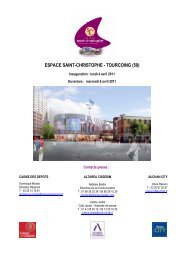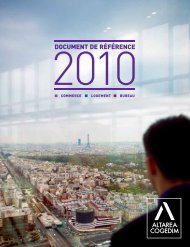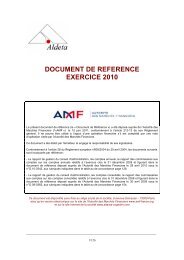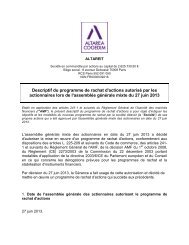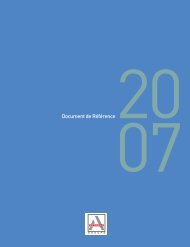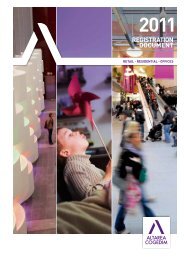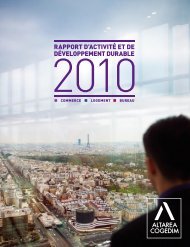Annual report 2008 - Altarea Cogedim
Annual report 2008 - Altarea Cogedim
Annual report 2008 - Altarea Cogedim
Create successful ePaper yourself
Turn your PDF publications into a flip-book with our unique Google optimized e-Paper software.
CONSOLIDATED FINANCIAL STATEMENTS<br />
7.30. Cash flow statement<br />
The cash flow statement is presented using the indirect<br />
method permitted under IAS 7. Tax expense is shown as a<br />
single item in cash flows from operating activities. Dividends<br />
received from associates are classified as cash flows from<br />
operating activities. Interest paid is shown in cash flows<br />
from financing activities, and interest received is shown<br />
in cash flows from investing activities. Dividends paid are<br />
classified as cash flows from financing activities.<br />
7.31. Operating Segments (IFRS 8)<br />
IFRS 8 “Operating Segments” requires the presentation of<br />
information for operating segments, chosen to conform to<br />
the Group’s organisation and its internal <strong>report</strong>ing system,<br />
that is presented according to IFRS recognition and<br />
measurement principles. Operating segments as defined<br />
in the standard are those that are reviewed by the Group’s<br />
Management on a regular basis and for which separate<br />
financial <strong>report</strong>ing is available.<br />
The internal <strong>report</strong>ing system is based on the operating<br />
segments described below. Segment <strong>report</strong>ing is presented<br />
according to two analytical axes:<br />
– Recurring Profit;<br />
– Non-Recurring Profit and Net Asset Value.<br />
Each segment receives services provided internally within<br />
the Group. The cost of these services is charged to each<br />
of the segments and recorded in overhead costs. As a<br />
consequence, no inter-segment services are presented.<br />
Reconciliation items make it possible to reconcile these<br />
<strong>report</strong>ing figures with the Group’s IFRS income statement<br />
and balance sheet.<br />
1. Recurring activities<br />
These measure the creation of wealth available for<br />
distribution from Recurring Profit.<br />
The two operating segments that constitute recurring<br />
activities are:<br />
(a) the owned shopping centre business;<br />
(b) the property development for third parties business.<br />
These are the segments used in the Group’s financial<br />
<strong>report</strong>ing.<br />
The indicators used to monitor each of these segments are:<br />
(a) the owned shopping centre business: net rental income,<br />
operating profit (including net overhead costs as described<br />
in note 11.3) and net recurring profit (including the net<br />
cost of debt)<br />
In France, the owned property business enjoys SIIC tax status.<br />
(b) the property development for third parties business: net<br />
property income, operating profit (including net overhead<br />
costs as described in note 11.3) and net recurring profit<br />
(including the net cost of debt and income taxes)<br />
2. Non-recurring activities<br />
These measure the value created by the Group during the<br />
period.<br />
The relevant indicator for monitoring value is the change in<br />
net asset value inclusive of transfer taxes, which gives rise to<br />
Non-Recurring Profit. The NAV presented is a going-concern<br />
NAV after tax on unrealised capital gains. This indicator is<br />
presented in detail in the business review.<br />
The change in NAV is reconciled with the income statement<br />
as follows:<br />
Prior year NAV<br />
+ Non-Recurring Profit<br />
+ Recurring Profit<br />
– Dividend payout<br />
+ Capital increase<br />
– Other reconciliation items<br />
= Current year NAV<br />
Non-recurring activities are monitored as an operating<br />
segment and by means of stand-alone items in the<br />
reconciliation of operating segment results with the Group’s<br />
income statement:<br />
(a) The own-account shopping centre development<br />
operating segment accounts for all of the non-capitalised<br />
development costs.<br />
(b) The other items of a non-recurring nature taken into<br />
account in the reconciliation with the Group-wide<br />
income statement consist mainly of the change in<br />
value of investment properties – the main indicator of<br />
portfolio value creation for the period – amortisation and<br />
impairment of the customer relationships acquired with<br />
the <strong>Cogedim</strong> purchase, impairments of the inventory of<br />
new transactions, the change in value of derivatives,<br />
the effect of discounting receivables and payables, the<br />
cost of the stock grant plan implemented following the<br />
acquisition of <strong>Cogedim</strong> (the cost of which depends on<br />
actual performance against the business plan presented<br />
by the management of that company when it was<br />
acquired) and the cost of the first demand guarantee on<br />
acquisition debt guaranteed by the shareholders.<br />
98



